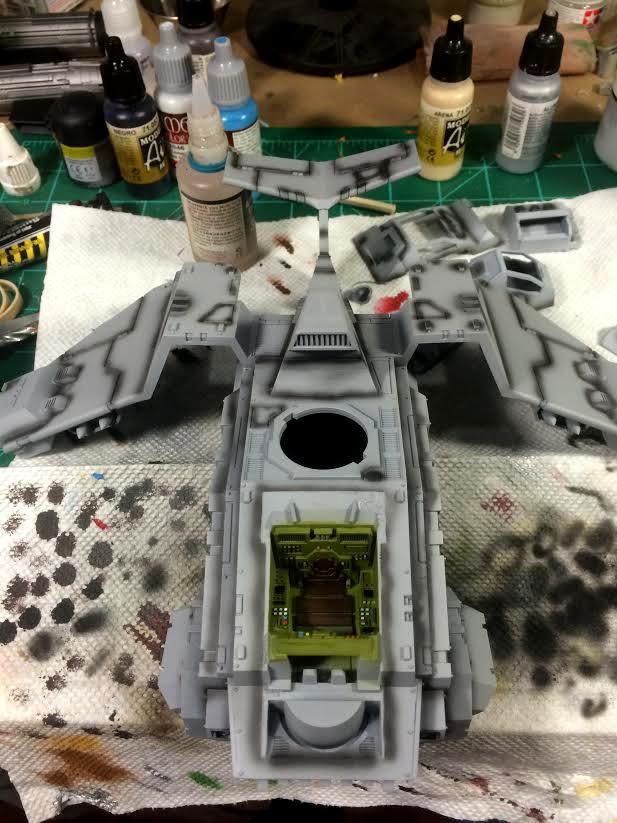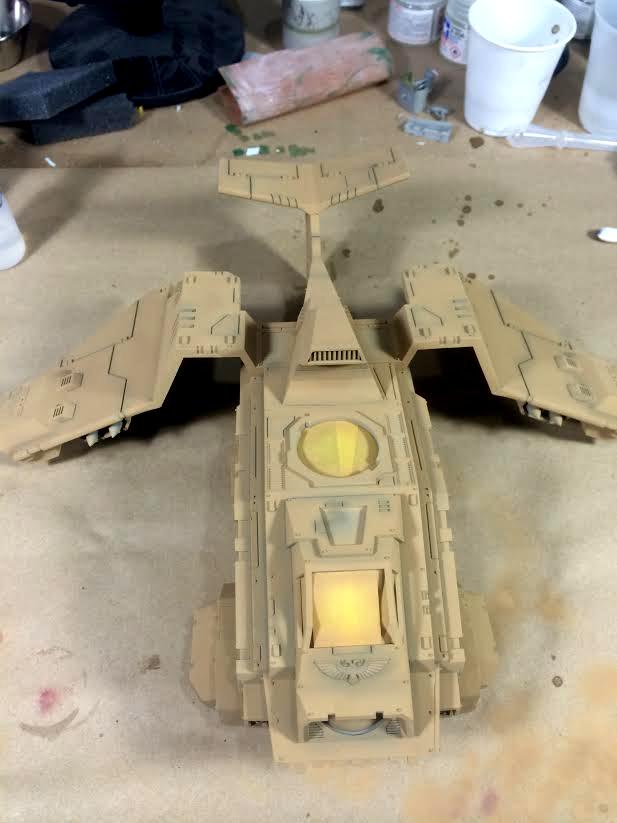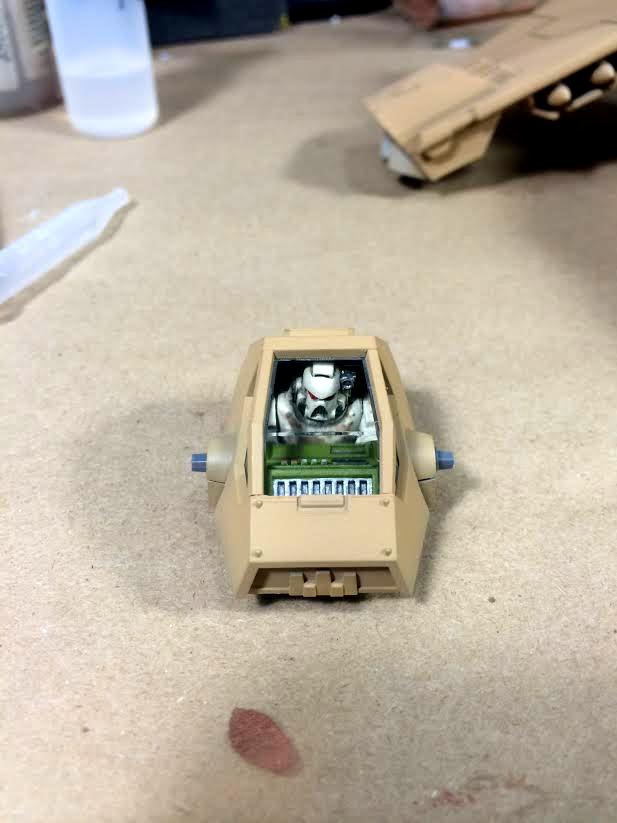This is a space marine Stormraven that I completed for an active duty US Marine. It goes along with a pair of Stormtalons I completed over the summer for the same client and also an Imperial Knight-Titan that I need to photograph. This model was pretty straight forward, the only real issue was the fact that it was partially assembled when I received it so considerable rework had to be done.
Showing posts with label Stormraven. Show all posts
Showing posts with label Stormraven. Show all posts
Saturday, December 6, 2014
Saturday, September 20, 2014
WIP: Space Marine Stormraven, Part 3
When we last left the Stormraven, a freshly laid coat of Tamiya Surface Primer was drying on the model. After it was cured, I used some Tamiya Liquid Surface Primer to fix a couple of spots I was unhappy with and after it was sanded down I reapplied some primer over the areas in question. After that, it was time for some preshading with VMA Black.
Preshading is a technique that makes use of the idea that an airbrush applies thin layers of paint. By darkening areas of the model with your desired color, you can affect the color of the basecoat by allowing some of the preshaded areas to show through the top coat. This can be adjusted depending on how much paint is applied on the topcoat. The result is subtle shading on the model that can bring depth to panel lines and shadows.
I then laid down the base color, again using Tamiya Desert Yellow (XF-59) like the Stormtalons that will be on the tabletop along with this model. Tamiya paints airbrush extremely smooth and leave an extra matte finish; the only downside is that they model is vulnerable to fingerprints, making gloves a necessity.
The client also requested a slight conversion to the model: replace the gun servitor in the turret with a Guardsmen or marine. I agree that it makes little sense that space marines would use a mindless servitor to man the gun on a craft like this. I raided my bits box and after some heavy modification, I managed to cram a space marine into the gun turret.
The engines and other metallic details were painted using a 1:1 mix of VMA Aluminum and VMA Black and along with the rest of the model, are awaiting a coat of Future in preparation of an oil wash and weathering.
Preshading is a technique that makes use of the idea that an airbrush applies thin layers of paint. By darkening areas of the model with your desired color, you can affect the color of the basecoat by allowing some of the preshaded areas to show through the top coat. This can be adjusted depending on how much paint is applied on the topcoat. The result is subtle shading on the model that can bring depth to panel lines and shadows.
I then laid down the base color, again using Tamiya Desert Yellow (XF-59) like the Stormtalons that will be on the tabletop along with this model. Tamiya paints airbrush extremely smooth and leave an extra matte finish; the only downside is that they model is vulnerable to fingerprints, making gloves a necessity.
The client also requested a slight conversion to the model: replace the gun servitor in the turret with a Guardsmen or marine. I agree that it makes little sense that space marines would use a mindless servitor to man the gun on a craft like this. I raided my bits box and after some heavy modification, I managed to cram a space marine into the gun turret.
The engines and other metallic details were painted using a 1:1 mix of VMA Aluminum and VMA Black and along with the rest of the model, are awaiting a coat of Future in preparation of an oil wash and weathering.
Sunday, September 14, 2014
WIP: Space Marine Stormraven, Part 2
After the oil paint had dried, I sealed everything in with matte varnish to protect it from the next layer of work to go in. I painted the steel grating with a 1:1 mix of Vallejo Model Air Steel and VMA Black, which as slowly become my go-to color for steel. I then painted all of the various details like the seats and the computer panels. I would normally do a gem effect for the screens like I did with my Land Raider, but given the fact that the interior was already assembled and getting my airbrush to the right angle would prove tricky, I just left them black. I then did two layers of sponge weathering, first using VMA Camo Black Brown and the second layer with VMA Black. I used various earth tone pigments to simulate dirt and followed everything up with some Tamiya Gun Metal pigment for the most worn corners and Tamiya Steel pigment for the metal grating.
I assembled the two hull pieces and glued them together with Tamiya Extra Thin cement and allowed it to dry using rubber bands to hold everything together. I then gave the entire model a coat of grey Tamiya Surface Primer from a rattle can. This primer is fast drying and gives a wonderful surface to work on. I chose the rattle can as opposed to my airbrush because of the large surface area of the model and because it takes to sanding much better than Vallejo Surface Primer. This is important because there are already a couple of areas that will require more filler and sanding.
I assembled the two hull pieces and glued them together with Tamiya Extra Thin cement and allowed it to dry using rubber bands to hold everything together. I then gave the entire model a coat of grey Tamiya Surface Primer from a rattle can. This primer is fast drying and gives a wonderful surface to work on. I chose the rattle can as opposed to my airbrush because of the large surface area of the model and because it takes to sanding much better than Vallejo Surface Primer. This is important because there are already a couple of areas that will require more filler and sanding.
Saturday, September 13, 2014
WIP: Space Marine Stormraven, Part 1
I received the next round of models from my client this week, a space marine Stormraven gunship and an Imperial Knight-Titan. These were bought second hand, which in my experience usually means poorly assembled and often with missing pieces. Unfortunately, these modes lived up to my low expectations.
The Stormraven is in two major pieces plus the engines. The bottom hull is one piece and the top hull/wings is the other. Of course, the cockpit was incomplete and glued shut. Luckily I was able to remove it with little to no damage to the pieces. I spent over an hour sanding all of the glue off the model. It appears it was put together with something like Tamiya Extra Thin Cement, which is a great glue. The person that put it together "painted" the surface of every joint with the stuff, which is not needed with this glue. To use it correctly, you just have to touch the joint with the brush and capillary action sucks the glue into the joint and you press and hold of a minute and it's done.
I started with the Stormraven, which as previously mention, was mostly assembled. Of course this makes painting the interior somewhat difficult. Luckily, the inside of the model is pretty large so I was able to get a nice coat of grey Vallejo Surface Primer down to begin painting. This is an instance where priming with an airbrush really pays off; there is no way I could have primed the interior with a spray can. After I allowed to the primer to cure for 24 hours, I gave the entire interior a couple of coats of my chosen interior green color: a 1:1 mix of Vallejo Model Air Pale Green and Vallejo Model Air US Grey Light. I chose this color based on the interior of modern APCs and IFVs, which are a light greenish color. I gave everything a coat of Future and after that dried, a wash of 502 Abteilung Starship Filth and then cleaned up the excess with a makeup applicator and odorless turpenoid. This was the result:
After the oil dries overnight, I will seal it in with matte varnish and begin painting the details by hand. I will also spray the the metal grating with VMA Gunmetal just for a little variation. After the details are painted, I will give the interior a little bit of sponge weathering and some pigments before it gets closed up.
The Stormraven is in two major pieces plus the engines. The bottom hull is one piece and the top hull/wings is the other. Of course, the cockpit was incomplete and glued shut. Luckily I was able to remove it with little to no damage to the pieces. I spent over an hour sanding all of the glue off the model. It appears it was put together with something like Tamiya Extra Thin Cement, which is a great glue. The person that put it together "painted" the surface of every joint with the stuff, which is not needed with this glue. To use it correctly, you just have to touch the joint with the brush and capillary action sucks the glue into the joint and you press and hold of a minute and it's done.
I started with the Stormraven, which as previously mention, was mostly assembled. Of course this makes painting the interior somewhat difficult. Luckily, the inside of the model is pretty large so I was able to get a nice coat of grey Vallejo Surface Primer down to begin painting. This is an instance where priming with an airbrush really pays off; there is no way I could have primed the interior with a spray can. After I allowed to the primer to cure for 24 hours, I gave the entire interior a couple of coats of my chosen interior green color: a 1:1 mix of Vallejo Model Air Pale Green and Vallejo Model Air US Grey Light. I chose this color based on the interior of modern APCs and IFVs, which are a light greenish color. I gave everything a coat of Future and after that dried, a wash of 502 Abteilung Starship Filth and then cleaned up the excess with a makeup applicator and odorless turpenoid. This was the result:
After the oil dries overnight, I will seal it in with matte varnish and begin painting the details by hand. I will also spray the the metal grating with VMA Gunmetal just for a little variation. After the details are painted, I will give the interior a little bit of sponge weathering and some pigments before it gets closed up.
Subscribe to:
Posts (Atom)











